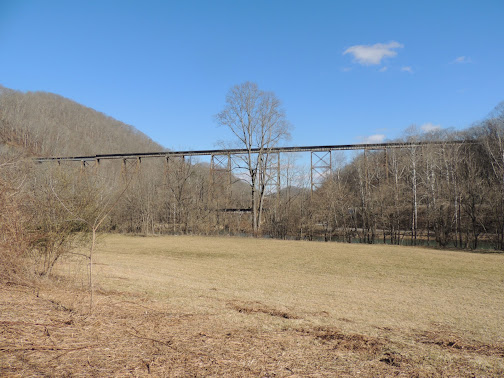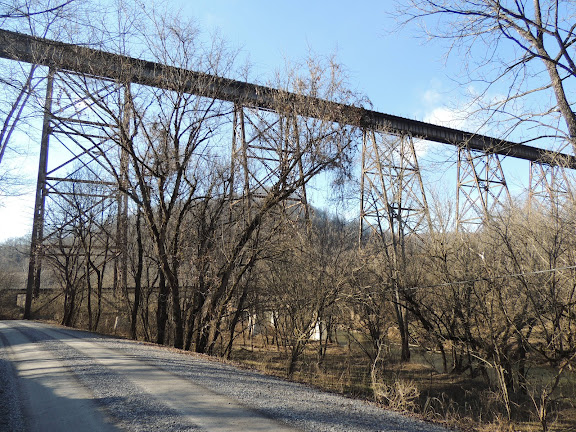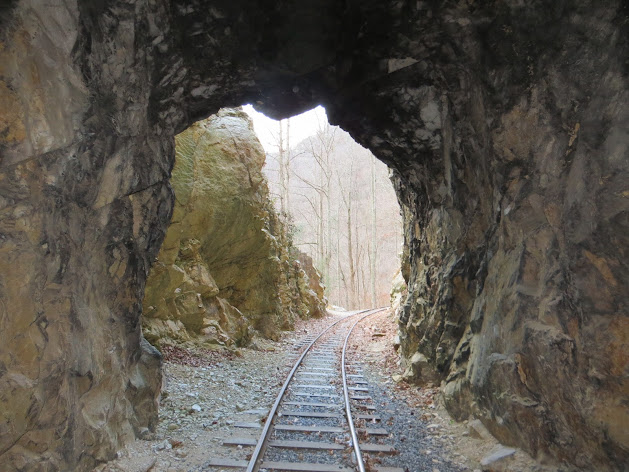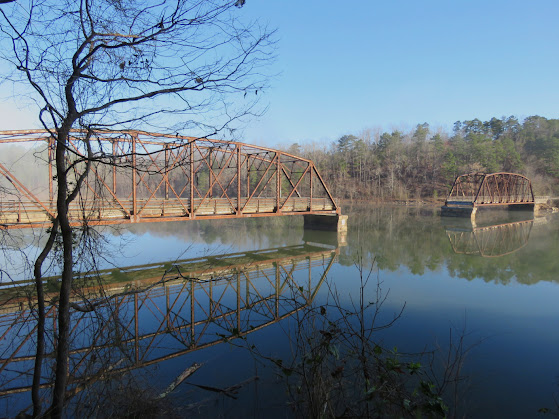Copper Creek Viaduct, Speers Ferry, VA
At the time it was built in 1908, it was the tallest railroad trestle, if not one of the tallest railroad trestles in the eastern United States. Although it was soon eclipsed by other higher railroad bridges, the Copper Creek Viaduct between Speers Ferry and Clinchport, Virginia has maintained a nostalgic, almost romantic influence on steel truss bridge lovers, this being a popular destination point.
Today, generations after the bridge was completed as part of 80 bridges on one of the most ambitious railroad lines in American history, the Copper Creek Viaduct is still one of the most photographed and talked-about steel deck truss bridges in this part of the country.
In 1902 when George Carter purchased the Ohio River and Charleston Railroad (earlier known as the 3-C Railroad -- Carolina, Clinchfield and Chicago), his ambitious idea of the railroad he quickly named the South and Western Railway (later the Clinchfield) often placed the railroad bed itself higher than the ground it would traverse.
In this case, instead of extensive low grading on the lower Copper Ridge terrain along the Clinch River shore from Dungannon to Speer's Ferry, Carter's general manager and chief engineer M.J. Caples continued the route concept that followed the lighter curves of the UPPER Copper Ridge high ABOVE the Clinch River and he would simply tunnel through any ridge extensions that would have required a deeper curve.
This ideology was copied many times on the Clinchfield route, including up and down the North Carolina Blue Ridge and through Virginia's Breaks Interstate gorge.
By the time the planned route in Scott County approached the lower Copper Creek valley cut, it was obvious that the upper grade would require a high trestle, much higher than the original 3-C planned route at a much lower elevation.
The result was the Copper Creek Viaduct, 1,091 feet long, towering 167 feet above the Copper Creek-Clinch River junction.
The trestle consists of 19 spans: 11 deck plate girders 70 feet long each, and 8 deck plate girders, each of those 40 feet long. Chief engineer Caples' calculations were only a few inches longer than the 1,090 feet total.
The bridge deck is supported by 9 braced steel bents, angled wider at the bottom and smaller at the top for weight stability. As with most steel truss bridges, the bents are in the form of tall triangle shapes, which give the bridge the strength to hold at least 213 tons, the maximum weight that Caples designed for all of Clinchfield's bridges.
The Copper Creek Bridge is located at milepost 78.80 of the old 277-mile long Clinchfield Railroad, which is now owned by CSX.
The viaduct was, and will always be a vital link in the transportation of coal and commodities from loading docks along the Ohio River above Elkhorn City, KY, down to the Atlantic and Gulf ports south of Spartanburg, SC. and Atlanta.
According to a plaque at the bridge's observation pull-off on the Daniel Boone Heritage Trail Highway (U.S. 23-58-421), at least 25 coal cars cross this trestle every single day.
If you're lucky at the observation area, you'll get to see the importance of the trestle to the area's economy, traveling north and southbound before your eyes.
After 115+ years, the Copper Creek Bridge still completes a vital transportation link for coal and commodities through the local area and on a global scale, shipments sent around the world.
Also very visible across Copper Creek directly in front of the former Clinchfield (CSX) Railroad trestle is a lower railroad trestle built by the Atlantic and Ohio Railroad around 1890, now owned by the Norfolk-Southern Railroad.
For years, the two railroads, the Clinchfield and the Southern, worked as bitter competitors for the rights to transport coal from the rich seams in Southwest Virginia and Eastern Kentucky.
Today, both railroads have agreements to share the other's track through Copper Creek and surrounding trackage, working right alongside each other. It's not unusual these days to see a CSX train on the N-S lower trestle, or a Norfolk-Southern train on the upper CSX trestle.
Full disclosure: I've been on the Clinchfield Copper Creek trestle one time, doing a "PM Magazine" story on the Santa Train for WATE-TV, Knoxville, TN back in 1983. I managed to be taking video from the train's locomotive just as it approached and ultimately crossed the Copper Creek trestle. The video from that story is here.
The feeling was euphoric.. almost like a bird flying over the lower creek valley, with the view of the trestle on one side and the Clinch River-U.S. 23-58-421 four-lane highway on the other. On a clear day, the view is miles in all directions.
The feeling only lasted a few seconds and very few people get to experience the view from the Copper Creek Bridge from the locomotive of a CSX train. It was the ride of a lifetime, one I will never forget.















